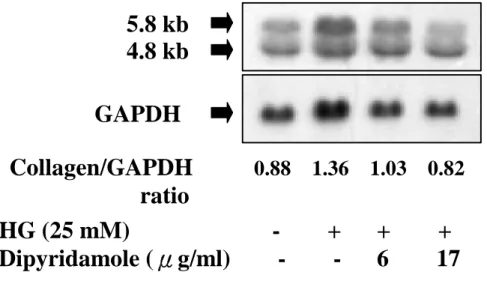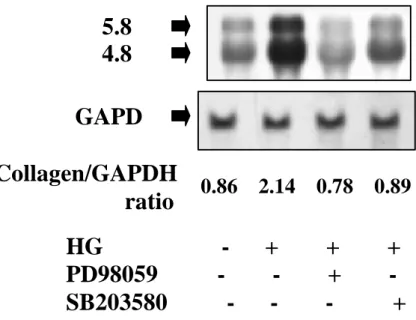行政院國家科學委員會補助專題研究計畫成果報告
※※※※※※※※※※※※※※※※※※※※※※※※※
※
※
※
Dipyridamole 抑制高糖透析液造成腹膜纖維化 ※
※
之作用機轉
※
※
※
※※※※※※※※※※※※※※※※※※※※※※※※※
計畫類別:■個別型計畫
□整合型計畫
計畫編號:NSC90-2314-B-002-272-
執行期間:90 年 9 月 1 日至 91 年 8 月 31 日
計畫主持人:洪冠予
共同主持人:蔡敦仁
本成果報告包括以下應繳交之附件:
□赴國外出差或研習心得報告一份
□赴大陸地區出差或研習心得報告一份
□出席國際學術會議心得報告及發表之論文各一份
□國際合作研究計畫國外研究報告書一份
執行單位:國立臺灣大學醫學院 內科
中
華
民
國
91
年
11
月
7
日
行政院國家科學委員會專題研究計畫成果報告
計畫編號 : NSC90-2314-B-002-272 執行期限:90 年 9 月 1 日 至 91 年 8 月 31 日 主持人:洪冠予 執行機構及單位名稱: 國立臺台灣大學醫學院內科 共同主持人:蔡敦仁 執行機構及單位名稱: 國立臺台灣大學醫學院內科一. 中文摘要
腹膜透析(PD)病人的腹膜長期接觸含高糖(high glucose, HG)成分的透析液,會發生 纖 維 硬 化 。 吾 人 曾 經 報 告 : TGF-β可 以 刺 激 人 類 腹 膜 表 面 細 胞 (human peritoneal mesothelial cell, HPMC)內纖維蛋白基因[type I collagen, proá1(I)]表現增加,此機轉可能 與活化傳遞路徑 ERK 有關,而且可以被 dipyridamole 抑制。而 HG 也可以刺激 HPMC 的 proá1(I)表現增加,但是 dipyridamole 的效果及機轉仍待釐清。本研究中吾人發現: HG 具有刺激 HPMC 中 ERK, p38 MAPK 等傳遞路徑活化、增進纖維蛋白基因 proá1(I)]表現 的作用。Dipyridamole 可以抑制上述 HG 的作用。吾人進一步探究發現: 使用 PD98059 或 SB203580, 各是 ERK 及 p38 MAPK 路徑的阻斷劑, 可以成功阻斷 HG 之刺激 HPMC 內 proá1(I)表現增加的作用。暗示: ERK 及 p38 MAPK 兩條路徑應該都參與 HG 之刺激 HPMC 內 proá1(I)表現增加的作用。Dipyridamole 雖然可以抑制 ERK 活化,但是卻不會 阻止 p38 MAPK 之被 HG 活化。 吾人初步結論是:dipyridamole 的確可以有抑制 HG 刺激 HPMC 內纖維蛋白基因表 現增加的效果,而此種作用的機轉主要可能予透過抑制 HPMC 內 ERK1/2 路徑被 HG 刺 激活化有關。 (關鍵詞:腹膜透析,dipyridamole,高糖,纖維蛋白,訊息傳遞)二. 英文摘要
High glucose (HG) contents of dialysate exerts fibrogenic effects on peritoneum of patients on peritoneal dialysis (PD). We previously had found in human peritoneal mesothelial cell (HPMC) that the fibrogenic effect of TGF-ß was mediated via activation of extracellular signal-regulated kinase (ERK) cascade and is suppressed by dipyridamole. However, the molecular mechanisms mediating fibrogenic reactions of HG in HPMC and whether it can be modulated by dipyridamole has never been investigated. HG (25 mM), compared with normal glucose (5.5 mM), significantly activate ERK1/2, p38 MAPK and increased type I pro-collagen [proá1(I)] mRNA level in HPMC. HPMC pre-treated with dipyridamole dose-dependently inhibit effects of HG. HPMC pre-treated with PD98059 and SB203580, which selectively inhibited ERK and p38 MAPK, respectively, prevented HG-induced proá1(I) mRNA upregulation. It implicated that both ERK and p38 MAPK are involved in response to HG. Dipyridamole inhibited the ERK activation, but not the activation of p38 MAPK, of HPMC by HG. We postulated that dipyridamole may inhibit the HG-induced matrix gene expression, thus may have clinical implications as therapeutic agents for prevention of peritoneal fibrosising syndrome (PFS).
三. 緣由與目的
Peritoneal fibrosing syndrome (PFS) represents a wide spectrum of peritoneal alterations observed in long-term peritoneal dialysis (PD) patients [1]. PFS is characterized by extracellular matrix (ECM) accumulation, particularly types I and III collagen and fibronectin, in the peritoneum. In vitro and in vivo studies have disclosed that high glucose (HG) content
of PD solutions stimulates peritoneal ECM production by human peritoneal mesothelial cells (HPMC) and fibroblast, thus aggreviates the development of PFS [2]. Pharmacological interventions that can attenuate HG–stimulated ECM accumulation in the peritoneum may have a therapeutic potential for the prevention or retardation of PFS.
Molecular studies had demonstrated that HG enhanced collagen gene expression in cultured HPMC [2]. However, the exact molecular mechanisms mediating HG-enhanced ECM expression by HPMC remains unclear. Recently, three mitogen-activated protein kinase (MAPK) families have been identified and characterized in HPMC; these are extracellular signal-regulated kinase (ERK), c-Jun NH2-terminal kinase (JNK), and p38 MAP kinase [3-5]. It has been reported that ERK and p38 MAPK are activated in rat mesangial cells cultured under HG condition [6]. Whether the MAPK family participated in the enhanced expression of ECM by HG in HPMC remains undetermined.
Dipyridamole is a clinically used anti-platelet agent. In addition to its anti-platelet activity, dipyridamole has been documented to act as an phosphodiesterase inhibitor that increases intracellular cAMP [4, 5]. In our previous report [5], we have demonstrated that dipyridamole, through increased intracellular cAMP, exerts an anti-fibrotic effect on TGF-β-stimulated ERK activation and collagen gene expression in HPMC.
The purposes of this project were: first, to examine effects of HG on type I pro-collagen [proá1(I)] gene expression in HPMC; and second, the possible role of MAPK pathway that participate in enhancement of proá1(I) expression in response to HG of HPMC were also studied. Third, the effect and mechanisms of dipyridamole on downstream signaling pathways of HG in HPMC was identified. We found in this work that ERK involeved in HG-stimulated proá1(I) gene expression in HPMC. Dipyridamole, by mechanisms that increased ERK activation, inhibits fibrogenic effects of HG in cultured HPMC.
四. 結果:
Effect of dipyr idamole on HG-induced pr oá1(I) gene expr ession in HPMC
We at first examined the effects of HG on proá1(I) gene expression in HPMC by Northern blot analysis. As shown in Figure 1, HG significantly upregulate proá1(I) gene expression. In contrast, HPMC cultured in normal glucose media (NG, 5.5 mM) did not induce proá1(I) mRNA expression, compared with control (data not shown). Next, we evaluated the inhibitory effect of dipyridamole on HG-induced proá1(I) gene expression in HPMC. Proá1(I) mRNA was significantly increased in HPMC cultured in HG, which was dose-dependently inhibited by dipyridamole (Figure 1). Dipyridamole had no significant inhibition on proá1(I) gene expression in HPMC cultured in NG media.
ERK is involved in HG-induced pr oá1(I) gene expr ession in HPMC
The increased expression of proá1(I) mRNA by HG probably involved the activation of the MAPK family. We therefore evaluated whether ERK or p38 was activated by HG in HPMC. HPMC were exposed to either NG or HG for 30 minutes to 24 hours. The ERK activity was analyzed by Western blots. As shown in Figure 2A, the activity of ERK was significantly enhanced in HPMC by exposure to HG, starting from 30 minutes through 24 hours. A similar result was observed of HG induced p38 activation in HPMC (Figure 2B). In contrast, NG did not produce a significant activation of ERK or p38 as compared with control. Next, we examined the involvement and biological significance of ERK or p38 in HG-induced proá1(I) gene expression in HPMC. After dose-dependent experiments, we found that PD98059 (25 ìM) or SB203580 (30 ìM), specific inhibitors of ERK or p38 MAPK pathways respectively, inhibited these two pathway by HG in HPMC. HPMC then were cultured in HG with PD98059 (25 ìM) or SB203580 (30 ìM) for 24 hours. We found that both inhibited the enhanced expression of proá1(I) by HG in HPMC (Figure 3). Taken these observations together, we found that both ERK and p38 pathways were involved in the upregulation of proá1(I) by HG in HPMC.
Effect of dipyr idamole on HG-induced activation of ERK
As dipyridamole inhibited the enhanced expression of proá1(I) mRNA by HG in HPMC (Figure 1), we assumed that this inhibitory effect of dipyridamole might mediate through modulations of MAPK activaiton by HG. As shown in Figure 2A, dipyridamole prevented the activation of ERK by HG in HPMC. The inhibitory effect of dipyridamole on HG-induced p38 activation was not observed in HPMC through 24 hours (Figure 2B).
五. 討論與計畫成果自評
Studies have demonstrated that adverse effects of HG on peritoneum was mediated through various signaling pathways of fibrogenic mediators [2]. It had been demonstrated that HG increased collagen gene expressions in HPMC. Albeit the involvement of protein kinase C (PKC) activation in the pathogenesis of diabetic complications has been well documented, the role of other protein kinases in the development of diabetic peritoneal effect, especially that of the collagen gene expression in HPMC has never been established. In this work, we showed by using immunoblot analysis that the ERK cascade is activated in HPMC grown in HG media. With the use of PD98059, a specific inhibitor of the ERK kinase MEK, we further demonstrated that ERK activation in HPMC is required for the stimulation of proá1(I) mRNA expression by HG.
We previously reported that dipyridamole inhibits ERK activation in HPMC exposed to serum (10% FCS) or TGF-ß [5, 7]. In this study, we showed that treatment of HPMC with dipyridamole significantly inhibits the HG-induced proá1(I) mRNA expression (Figure 1). Furthermore, and consistent with the requirement for ERK phosphorylation in the stimulation of proá1(I) mRNA by HG, we showed that dipyridamole modulated the activations of ERK by HG (Figure 2A). Nevertheless, at the concentration (17 ìg/ml) that inhibited proá1(I) gene expression by HG, dipyridamole did not prevent the p38 activation by HG (Figure 2B). Two possible mechanisms may be responsible for these reciprocal effects of dipyridamole.
First, the p38 MAPK pathway did involved in the proá1(I) gene expressions stimulated by HG (Figures 2B and 3), but was not altered by dipyridamole. The second possibility is that dipyridamole inhibited HG-induced proá1(I) gene expression through mechanisms
proá1(I) gene expression. Further study is needed to clarify this issue.
六. 參考文獻
1. Hung KY, Tsai TJ, Chen WY. Peritoneal fibrosis and its prevention. Nephrology 2002; 7:
227-232
2. Ha H, Lee HB. Peritoneal mesothelial cell biology in peritoneal dialysis. Nephrology 2002;
7: 220-226
3. Hung KY, Huang JW, Chen CT, Lee PH, Tsai TJ. Pentoxifylline modulates intracellular signaling of TGF-β in cultured human peritoneal mesothelial cells: implications for prevention of encapsulating peritoneal sclerosis. Nephrol Dial Transplant 2003; (in press)
4. Hung KY, Chen CT, Yen CJ, Lee PH, Tsai TJ, Hsieh BS. Dipyridamole Inhibits PDGF-stimulated Human Peritoneal Mesothelial Cell Proliferation. Kidney Int 2001; 60:
872-881
5.
Hung KY, Chen CT, Huang JW, Lee PH, Tsai TJ, Hsieh BS. Dipyridamole Inhibits TGF-β-Induced Collagen Gene Expression in Human Peritoneal Mesothelial Cells.Kidney Int 2001; 60: 1249-1257
6.
Haneda M, Araki S, Togawa M, Sugimoto T, Isono M, Kikkawa R: Mitogen-activated protein kinase cascade is activated in glomeruli of diabetic rats and glomerular mesangial cells cultured under high glucose conditions. Diabetes 1997; 46: 847-8537.
Hung KY, Shyu RS, Fang CC, Tsai CC, Lee PH, Tsai TJ, Hsieh BS. Dipyridamole Inhibits Human Peritoneal Mesothelial Cell Proliferation in vitro and Attenuates RatFigure 1. The effect of dipyridamole on HG-induced proá1(I) mRNA expression of HPMC. HPMC were cultured in HG media with various concentrations of dipyridamole (0, 6, 17 µg/ml) for 24 h. Representative Northern blots of three different experiments were shown. HG media increased proá1(I) mRNA levels, and dipyridamole treatment dose-dependently abolish these effects of HG.
(A)
Time (Hr )
0 0.5 0.5 1 1 8 8 24 24
24
HG - + + + + + + + +
Dipyr idamole - - + - + - + - +
p-ERK
1
p-ERK
2
ERK2
ERK1
GAPDH
5.8 kb
4.8 kb
HG (25 mM) - + + +
Dipyr idamole (μg/ml) - - 6 17
Collagen/GAPDH
r atio
0.88 1.36 1.03 0.82
(B)
P- P38
P38
Time (Hr )
0 0.5 0.5 1 1 8 8 24 24
HG - + + + + + + + +
Dipyr idamole - - + - + - + - +
Figure 2. Activation of (A) ERK and (B) p38 MAPK in HPMC cultured in HG with or without dipyridamole. HPMC were cultured in HG (25 mM) media for 30 mins to 24 h. The activity of ERK and p38 MAPk were measured by immunoblotting using anti-phospho-ERK antibody (upper band) and anti-ERK2 antibody (lower band), respectively. The phosphorylation of pp38 and p38 protein content were analyzed as described for ERK pathway.
Figure 3. The effects of PD98059 and SB203580 on HG-increased proá1(I) mRNA expression. HPMC was cultured in HG media with PD98059 (25 µM) or SB203580 (30 µM) for 24 h. Representative Northern blot from five experiments with similar results were shown.

